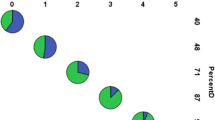Abstract
We identify youth who are at risk for a critical transition from mental health to juvenile justice. A statewide longitudinal sample of Medicaid-eligible youth (aged 10–17) in the public mental health system (n = 5,455), during approximately one fiscal year (July 1, 1994–August 30, 1995), was used to determine the risk factors for, and timing of, a subsequent juvenile justice detention or commitment during the three subsequent fiscal years (1994–1997). Logistic regression and Cox Proportional Hazards modeling were used. Risk factors for juvenile justice detention or commitment included being: male, black or Hispanic, in junior high school, involuntarily admitted to mental health, having a DSM-IV diagnosis of conduct disorder, alcohol problems, a constellation of risk behavior, and receiving prior mental health services. Factors that accelerate the timing of detention or commitment in the juvenile justice system after a mental health visit included most of the general risk factors except risk behavior and involuntary admission were no longer significant and having a DSM-IV nonalcohol drug use diagnosis, antisocial behavior, and school problems became significant. Our study helps to identify youth who are at risk for multiple system use so that they may be provided appropriate services to prevent multiple system use.
Similar content being viewed by others
REFERENCES
Alterman, A., Langenbucher, J., & Morrison, R.L. (2001). State-level treatment outcome studies using administrative data bases. Evaluation Review, 25, 162–183.
American Psychiatric Association. (1994). Diagnostic and Statistical Manual of Mental Disorders (4th Edition). Washington, DC: American Psychiatric Association.
Burns, B.J., Costello, E.J., Angold, A., Tweed, D., Stangl, D., Farmer, E.M.A., & Erkanli, A. (1995). Children's mental health service use across service sectors. Health Affairs, 14, 147–159.
Burns, B.J., Costello, E.J., Erkanli, A., Tweed, D.L., Farmer, E.M.Z., & Angold, A. (1997). Insurance coverage and mental health service use by adolescents with serious emotional disturbance. Journal of Child and Family Studies, 6, 89–111.
Cornell, P. (1980). Prior adjustment of violent juvenile offenders. Law and Human Behavior, 14, 569–577.
Elliot, D.S., & Ageton, S.S. (1980). Reconciling race and class differences in self-report and official estimates of delinquency. American Sociological Review, 45, 95–110.
Elliot, D.S., Huizinga, D., & Ageton, S.S. (1985). Explaining delinquency and drug use. London: Sage Publishers.
Ellis, R.H., Wackwitz, J.H., & Foster, M. (1991). Uses of an empirically derived client typology based on level of functioning: Twelve years of the CCAR. The Journal of Mental Health Administration, 18,89–100.
Evens, C.C., & Vander Stoep, A. (1997). Risk factors for juvenile justice system referral among children in a public mental health system. The Journal of Mental Health Administration, 24, 443–455.
Glied, S., Hoven, C.W., Moore, R.E., Garrett, A.B., & Regier, D.A. (1997). Children's access to mental health care: Does insurance matter? Health Affairs, 16, 167–174.
Glisson, C. (1994). The effect of service coordination teams on outcome for children in state custody. Administration in Social Welfare, 18(4), 1–23.
Kendall. P.C., & MacDonald, J.P. (1993). Cognition in the development of psychopathology in youth: Implications for treatment. In K.S. Dobson & P. C. Kendall (Eds.), Psychopathology and cognition (pp. 387–427). New York: Academic Press.
Lewis, D.O., Balla, D.A., & Shanok, S.S. (1979). Some evidence of race bias in diagnosis and treatment of juvenile offenders. American Journal of Orthopsychiatry, 49, 53–61.
Lewis, D.O., Shanok, S.S., Cohen, R.J., Kligfeld, M., & Friscone, G. (1980). Race bias in the diagnosis and disposition of violent adolescents. American Journal of Psychiatry, 137, 1211–1216.
Mason, M.A. & Gibbs, J.R. (1992). Patterns of adolescent psychiatric hospitalization: Implications for social policy. American Journal of Orthopsychiatry, 62, 447–457.
Melton, G.B., & Pagliocca, P.M. (1992). Treatment in the juvenile justice system: Directions for policy and practice. In J. J. Cocozza (Ed.), Responding to the mental health needs of youth in the juvenile justice system (pp. 107–139). Seattle: The National Coalition for the Mentally Ill in the Criminal Justice System.
OJJDP Statistical Briefing Book. December, 2000. Online. Available: http://ojjdp.ncjrs.org/ojstatbb/ qa253.html.
Otto, R.K., Greenstein, J.J, Johnson, M.K, & Friedman, R.M. (1992). Prevalence of mental disorders among youth in the juvenile justice system. In J.J. Cocozza (Ed.), Responding to the mental health needs of youth in the juvenile justice system. (pp. 7–48). Seattle: The National Coalition for the Mentally Ill in the Criminal Justice System.
Patterson, G.R., De Baryshe, B.D., & Ramsey, E. (1989). A developmental perspective on antisocial behavior. American Psychologist, 44, 329–335.
Pumariega, A.J., Nace, D., England, M.J., Diamond, J., Fallon, T., Hanson, G., Lourie, I., Marx, L., Solnit, A., Grimes, C., Taurber, D., & Graham, M. (1997). Community-based systems approach to children's managed mental health services. Journal of Child and Family Studies, 6, 149–164.
Rosenblatt, J.A., Rosenblatt, A., & Biggs, E.E. (2000). Criminal behavior and emotional disorder: Comparing youth served by the mental health and juvenile justice systems. Journal of Behavioral Health Services and Research, 27, 227–237.
Scott, M., Snowden, L.,& Libby, A. (2001). Effects of a Medicaid capitated mental health carve-out on youth contact with the juvenile justice system in Colorado. Manuscript submitted for publication.
Snyder, H., & Sickmund, M. (1999). Juvenile offenders and victims: 1999 National Report. Washington, D.C.: Office of Juvenile Justice and Delinquency Prevention.
Vander Stoep, A., Evens, C.C., & Taub, J. (1997). I. Risk of juvenile justice system referral among children in a public mental health system. The Journal of Mental Health Administration, 24, 428–442.
Walker, J.L., Lahey, B.B., Russo, M.F., Frick, P.J., Christ, M.G., McBurnett, K., Loeber, R., Stouthammer-Loeber, M., & Green, S. (1991). Anxiety, inhibitions and conduct disorder in children: I. Relations to social impairment. Journal of the American Academy of Child and Adolescent Psychiatry, 30, 187.
Westendorp, F., Brink, K.L., Roberson, M.K., & Ortiz, I.E. (1986). Variables which differentiate placement of adolescents into juvenile justice or mental health systems. Adolescence, 21, 23–37.
Author information
Authors and Affiliations
Corresponding author
Rights and permissions
About this article
Cite this article
Scott, M.A., Snowden, L. & Libby, A.M. From Mental Health to Juvenile Justice: What Factors Predict This Transition?. Journal of Child and Family Studies 11, 299–311 (2002). https://doi.org/10.1023/A:1016820106641
Issue Date:
DOI: https://doi.org/10.1023/A:1016820106641




